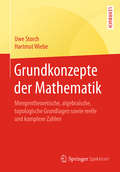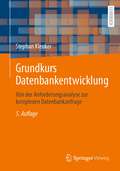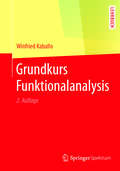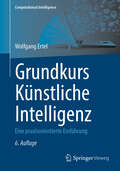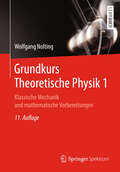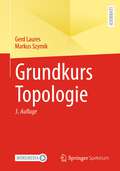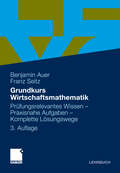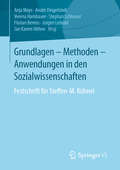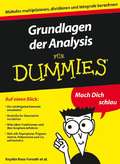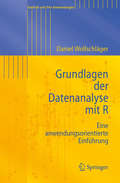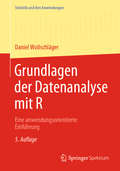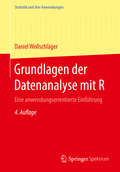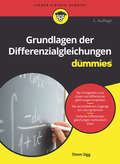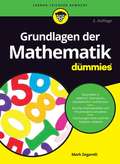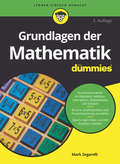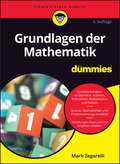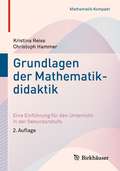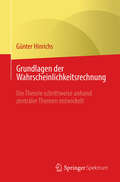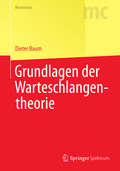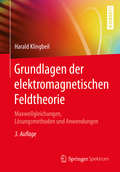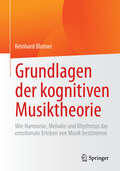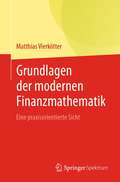- Table View
- List View
Grundkonzepte der Mathematik
by Uwe Storch Hartmut WiebeDieses Buch vermittelt wesentliche Grundlagen der Mathematik, und zwar aus der Mengenlehre, der Algebra, der Theorie der reellen und komplexen Zahlen sowie der Topologie. Es ist damit die Basis für eine weiterführende Beschäftigung mit der Mathematik. Nicht nur die nötigen Begriffe werden eingeführt, sondern bereits wesentliche – auch tieferliegende – Aussagen darüber bewiesen. Der Stoff wird durch ungewöhnliche Beispiele und vielfältige Aufgaben illustriert und ergänzt. Das Buch ist zum Selbststudium geeignet, aber vor allem konzipiert als Begleitlektüre von Anfang an für ein Studium der Mathematik, Physik und Informatik. Die stringente Herangehensweise macht es gut lesbar und vergleichsweise leicht verständlich.
Grundkurs Datenbankentwicklung: Von der Anforderungsanalyse zur komplexen Datenbankanfrage
by Stephan KleukerMit diesem Buch erhalten Studierende einen kompakten und praxisorientierten Einstieg, mit dem sie bereits früh im Studium sehr gut zurechtkommen. Die verschiedenen Phasen einer Datenbankentwicklung werden mit ihren Vorgehensweisen, Konzepten und möglichen Problemquellen vorgestellt. Gerade die Anforderungsanalyse und die Möglichkeit zur Erstellung mächtiger SQL-Anfragen werden als besonders praxisrelevante Aspekte betont. Durch die im zweiten Teil detailliert vorgestellte Integration von Datenbanken in die umgebende Software sind Studierende nach der Lektüre in der Lage, in Praxisprojekten erfolgreich mitzuarbeiten. Das Buch deckt inhaltlich eine Einführungsvorlesung vollständig ab. Die 5. Auflage wurde um das Thema JPA (Objekt-Relationale-Persistenz), Trigger in Java ergänzt. Zusätzlich werden Unterschiede zwischen Oracle, Maria DB, SQLite und Apache Derby erläutert. Neben vielen kleinen Beispielen zur Verdeutlichung einzelner Aspekte wird ein durchgehendes Beispiel genutzt. Alle Kapitel schließen mit Wiederholungsfragen und Übungsaufgaben, deren Lösungen online zum Download zur Verfügung stehen.
Grundkurs Funktionalanalysis
by Winfried KaballoIn diesem Buch finden Sie die Grundlagen der Funktionalanalysis, die im ersten Drittel des 20. Jahrhunderts entwickelt wurden. Ausgehend von konkreten Fragen der Analysis lernen Sie Methoden zur Untersuchung linearer Operatoren zwischen Hilbertr#65533;umen und Banachr#65533;umen kennen und wenden diese auf Fourier-Reihen, lineare Integral- und Differentialgleichungen und in der Quantenmechanik an. Das Buch eignet sich hervorragend als Begleitlekt#65533;re zu einer einf#65533;hrenden Vorlesung #65533;ber Funktionalanalysis und auch zum Selbststudium. . Es ist sehr ausf#65533;hrlich und leicht verst#65533;ndlich geschrieben, die Konzepte und Resultate werden durch zahlreiche Beispiele und Abbildungen illustriert. Anhand vieler #65533;bungsaufgaben k#65533;nnen Sie Ihr Verst#65533;ndnis des Stoffes testen, anhand anderer diesen selbstst#65533;ndig weiterentwickeln. L#65533;sungen finden Sie auf der Webseite zum Buch zum Buch unter www. springer. de. An Vorkenntnissen ben#65533;tigen Sie nur "Analysis I", Grundlagen der Linearen Algebra und der Topologie metrischer R#65533;ume sowie Vertrautheit mit Lebesgue-Integralen. Bei Bedarf k#65533;nnen Sie viele dieser Vorkenntnisse mittels des ausf#65533;hrlichen Anhangs auffrischen.
Grundkurs Künstliche Intelligenz: Eine praxisorientierte Einführung (Computational Intelligence)
by Wolfgang ErtelIn diesem Buch werden alle Teilgebiete der KI kompakt, leicht verständlich und anwendungsbezogen vorgestellt. Der Autor kennt das Gebiet nicht nur bestens aus Forschung und praktischer Anwendung, sondern engagiert sich auch erfolgreich in der Lehre. Die Themen reichen von der klassischen Logik über das Schließen mit Unsicherheit und maschinelles Lernen bis hin zu Anwendungen wie Diagnosesysteme, lernfähige Roboter oder Kreativität in der KI. Die 6. Auflage erweitert den Teil über Large Language Models und bietet ein neues Kapitel über die Auswirkungen von KI auf die heutige Gesellschaft. Sie profitieren von dem umfassenden Einblick in dieses faszinierende Teilgebiet der Informatik, wobei, abgesehen von grundlegenden Programmierkenntnissen sowie etwas Mathematik, alle Voraussetzungen für ein gutes Verständnis bereitgestellt werden. Sie gewinnen vertiefte Kenntnisse, z. B. hinsichtlich der wichtigsten Verfahren zur Repräsentation und Verarbeitung von Wissen und in dem immer wichtiger werdenden Gebiet des maschinellen Lernens. Vor allem der Anwendungsbezug steht im Fokus der Darstellung. Viele Übungsaufgaben mit Lösungen sowie eine strukturierte Liste mit Verweisen auf Literatur und Ressourcen im Web ermöglichen ein effektives und kurzweiliges Selbststudium.
Grundkurs Theoretische Physik 1: Klassische Mechanik (Springer-Lehrbuch)
by Wolfgang NoltingDer Grundkurs Theoretische Physik deckt in sieben Bänden alle für Diplom- und Bachelor/Master-Studiengänge maßgeblichen Gebiete ab. Jeder Band vermittelt das im jeweiligen Semester nötige theoretisch-physikalische Rüstzeug. Übungsaufgaben mit ausführlichen Lösungen dienen der Vertiefung des Stoffs. Band 1 behandelt die klassische Mechanik. Vorausgesetzt wird nur die übliche Schulmathematik, andere mathematische Hilfsmittel werden zu Beginn ausführlich erläutert. Die zweifarbig gestaltete Neuauflage wurde grundlegend überarbeitet und ergänzt.
Grundkurs Topologie
by Gerd Laures Markus SzymikDie Topologie beschäftigt sich mit den qualitativen Eigenschaften geometrischer Objekte. Ihr Begriffsapparat ist so mächtig, dass kaum eine mathematische Struktur nicht mit Gewinn topologisiert wurde.Dieses Buch versteht sich als Brücke von den einführenden Vorlesungen der Analysis und Linearen Algebra zu den fortgeschrittenen Vorlesungen der Algebraischen und Geometrischen Topologie. Es eignet sich besonders für Studierende in einem Bachelor- oder Masterstudiengang der Mathematik, kann aber auch zum Selbststudium für mathematisch Interessierte dienen.Die Autoren legen besonderen Wert auf eine moderne Sprache, welche die vorgestellten Ideen vereinheitlicht und damit erleichtert. Definitionen werden stets mit vielen Beispielen unterlegt und neue Konzepte werden mit zahlreichen Bildern illustriert. Über 170 Übungsaufgaben (mit Lösungen zu ausgewählten Aufgaben auf der Website zum Buch) helfen, die vermittelten Inhalte einzuüben und zu vertiefen. Viele Abschnitte werden ergänzt durch kurze Einblicke in weiterführende Themen, die einen Ausgangspunkt für Studienarbeiten oder Seminarthemen bieten.Neben dem üblichen Stoff zur mengentheoretischen Topologie, der Theorie der Fundamentalgruppen und der Überlagerungen werden auch Bündel, Garben und simpliziale Methoden angesprochen, welche heute zu den Grundbegriffen der Geometrie und Topologie gehören.
Grundkurs Wirtschaftsmathematik: Pr�fungsrelevantes Wissen - Praxisnahe Aufgaben - Komplette L�sungswege
by Benjamin R. Auer Franz SeitzDas erste Buch zur Wirtschaftsmathematik mit kompletten Lösungswegen! Es umfasst in kompakter Weise das für ein Wirtschaftsstudium benötigte mathematische Grundwissen. Konzentriert und präzise werden die für das Grundstudium bedeutsamen Bereiche der Wirtschaftsmathematik vermittelt. Die "ausführlichen" Lösungswege machen den Stoff leicht verständlich und nachvollziehbar. D.h. über die schlichte Darstellung einer Lösung hinaus werden Ihnen auch die zum echten Verständnis der Materie notwendigen einzelnen Denkschritte gezeigt. So begreifen Sie die Funktionsweise und erfassen die Logik, die dahinter steht. Die zahlreichen Übungsaufgaben sichern Ihnen den Erfolg in der Klausur.
Grundkurs partielle Differentialgleichungen: Eine Einführung für natur- und ingenieurwissenschaftliche Studiengänge (essentials)
by Jan SwobodaDas essential gibt Bachelor- und Masterstudierenden der Natur- und Ingenieurwissenschaften eine kompakte Einführung in die Mathematik der partiellen Differentialgleichungen. Im Fokus stehen dabei explizite Lösungsmethoden für die drei wichtigsten Grundtypen linearer partieller Differentialgleichungen: Laplacegleichung, Wärmeleitungsgleichung und Wellengleichung. Diese werden aus dem jeweiligen physikalischen Kontext motiviert. Es werden Lösungsverfahren für eine Reihe von typischen Anfangs- und Randwertaufgaben vorgestellt. Die diesen zugrundeliegenden analytischen Methoden, u.a. Fourierreihen und die Fouriertransformation, werden in einem eigenen Kapitel in knapper Form zusammengefasst.
Grundlagen - Methoden - Anwendungen in den Sozialwissenschaften: Festschrift für Steffen-M. Kühnel
by Anja Mays André Dingelstedt Verena Hambauer Stephan Schlosser Florian Berens Jürgen Leibold Jan Karem HöhneDiese Festschrift zu Ehren Steffen M. Kühnels versammelt eine Vielzahl von Beiträgen zu verschiedenen Themengebieten, mit denen sich der renommierte Soziologe in den vergangenen Jahrzehnten beschäftigt hat. In rund 35 Artikeln diskutieren deutsche und internationale Expertinnen und Experten zentrale Fragen der empirischen Sozialforschung. Die inhaltliche Vielfalt der Beiträge spiegelt dabei das breite Forschungsinteresse und langjährige Schaffen von Steffen M. Kühnel wider. Der erste Teil der Festschrift setzt sich mit der (Weiter-)Entwicklung von statistischen Verfahren und empirischen Forschungsmethoden auseinander. Hierbei wird auch wissenschaftstheoretischen Fragestellungen nachgegangen. Der zweite Teil behandelt Themen der angewandten Sozialforschung und untersucht aktuelle Fragen, insbesondere aus den Bereichen der politischen Wahlen und Partizipation sowie der Einstellungs- und Vorurteilsforschung.Dr. Anja Mays, Institut für Soziologie, TU Darmstadt.Dr. André Dingelstedt, Institut für Qualitätssicherung und Transparenz im Gesundheitswesen (IQTIG), Berlin.Verena Hambauer, Methodenzentrum Sozialwissenschaften, Universität Göttingen.Stephan Schlosser, Methodenzentrum Sozialwissenschaften, Universität Göttingen.Florian Berens, Methodenzentrum Sozialwissenschaften, Universität Göttingen.Dr. Jürgen Leibold, Methodenzentrum Sozialwissenschaften, Universität Göttingen.Jan-Karem Höhne, Universität Mannheim.
Grundlagen der Analysis für Dummies (Für Dummies)
by Deborah J. Rumsey Michelle Rose Gilman Christopher Burger Krystle Rose ForsethAuf Kriegsfuß mit der Analysis stehen, ist keine Schande. Wenn man sie aber beherrschen muss, hilft das nicht viel. Aber es gibt Abhilfe: Dieses Buch erklärt Ihnen die Grundlagen der Analysis und liefert Ihnen so ein Fundament, auf dem Sie Ihre weiteren Rechenkünste aufbauen können. So erfahren Sie, was Sie über Trigonometrie und Analytische Geometrie wissen müssen, um in der Analysis bestehen zu können. Außerdem erklären Ihnen die Autoren die ersten Schritte in Differentation und Integration und zur Auswertung der Grenzwerte. So gerüstet, können Sie sich getrost der Analysis stellen.
Grundlagen der Datenanalyse mit R
by Daniel WollschlägerDieses Buch liefert eine anwendungsorientierte Einführung in die Grundlagen der Datenauswertung mit dem freien Statistikpaket R. Es behandelt deskriptive Auswertungen ebenso wie inferenzstatistische Analysen. Neben den geläufigsten univariaten Verfahren berücksichtigt es nonparametrische sowie ausgewählte multivariate Methoden. Zudem deckt es die vielfältigen Möglichkeiten ab, Diagramme zu erstellen und Daten mit anderen Programmen auszutauschen. Die statistischen Verfahren werden an Beispielen erläutert und an vielen Stellen mit Diagrammen illustriert. Hinzu kommen manuelle Kontrollrechnungen, um die Ergebnisse von R Schritt für Schritt nachvollziehbar zu machen. Das Buch richtet sich an alle, die R kennenlernen und in konkreten Aufgabenstellungen einsetzen möchten, ohne bereits über Vorerfahrungen mit befehlsgesteuerten Programmen oder Programmiersprachen zu verfügen.
Grundlagen der Datenanalyse mit R: Eine anwendungsorientierte Einführung (Statistik und ihre Anwendungen)
by Daniel WollschlägerDieses Buch liefert eine anwendungsorientierte Einführung in die Datenauswertung mit der freien Statistikumgebung R. Es behandelt deskriptive Auswertungen ebenso umfassend wie inferenzstatistische Analysen. Neben klassischen univariaten Verfahren berücksichtigt das Buch nonparametrische Tests, Resampling-Methoden und multivariate Statistik. Zudem deckt es die vielfältigen Möglichkeiten ab, Daten aufzubereiten und Diagramme zu erstellen. Die statistischen Verfahren werden anhand von Beispielen erläutert und an vielen Stellen mit Diagrammen illustriert. Das Buch richtet sich an alle, die R kennenlernen und in konkreten Aufgabenstellungen einsetzen möchten, ohne bereits über Vorerfahrungen mit befehlsgesteuerten Programmen oder Programmiersprachen zu verfügen. Für die fünfte Auflage wurde das Buch vollständig aktualisiert: Es bezieht sich nun auf die Version 4.0.0 von R, auch die Auswahl und Darstellung verwendeter Zusatzpakete wurde der dynamischen Entwicklung angepasst. Außerdem wurde insbesondere der Abschnitt zur Datenaufbereitung überarbeitet: Zur stärkeren Ausrichtung auf Data-Science-Anwendungen stellt er nun ausführlich das Paket dplyr vor, enthält eine erweiterte Darstellung von R-Markdown-Dokumenten und bespricht Hinweise zur Reproduzierbarkeit von Auswertungen.
Grundlagen der Datenanalyse mit R: Eine anwendungsorientierte Einführung (Statistik und ihre Anwendungen)
by Daniel WollschlägerDieses Buch liefert eine anwendungsorientierte Einführung in die Datenauswertung mit der freien Statistikumgebung R. Es behandelt deskriptive Auswertungen ebenso umfassend wie inferenzstatistische Analysen. Neben klassischen univariaten Verfahren berücksichtigt das Buch nonparametrische Tests, Resampling-Methoden und multivariate Statistik. Zudem deckt es die vielfältigen Möglichkeiten ab, Daten aufzubereiten und Diagramme zu erstellen. Die statistischen Verfahren werden anhand von Beispielen erläutert und an vielen Stellen mit Diagrammen illustriert.Das Buch richtet sich an alle, die R kennenlernen und in konkreten Aufgabenstellungen einsetzen möchten, ohne bereits über Vorerfahrungen mit befehlsgesteuerten Programmen oder Programmiersprachen zu verfügen. In die vierte Auflage sind sowohl die Neuerungen von R 3.3.2 als auch jüngere Entwicklungen bei den Zusatzpaketen eingeflossen. Gleichzeitig wurde der Text überarbeitet und um ein eigenes Kapitel zu Diagrammen mit ggplot2 erweitert. Der Text behandelt nun auch allgemeine numerische Methoden wie Nullstellensuche, numerische Integration und Ableitung sowie numerische Optimierung.
Grundlagen der Differenzialgleichungen für Dummies (Für Dummies)
by Timm SiggDifferenzialgleichungen sind Ihnen ein Buch mit sieben Siegeln? Kein Problem! Im ersten Teil liefert Ihnen dieses Buch wirklich alles, was Sie an Handwerkszeug zum Lösen von Differenzialgleichungen benötigen. Anschließend erfahren Sie, was Differenzialgleichungen überhaupt sind und mit welchen Methoden man sie lösen kann. Im dritten Teil wird es ernst: Sie werden einfache Differenzialgleichungen rechnerisch lösen. Aber keine Sorge: Vielfältige Beispiele geben Ihnen die Gelegenheit, die Verfahren gründlich zu üben. Und damit Sie wissen, warum Sie sich all diesen Mühen unterziehen, werden Sie zuletzt auf berühmte Differenzialgleichungen aus Biologie, Chemie, Physik und Ökonomie treffen.
Grundlagen der Mathematik für Dummies (Für Dummies)
by Mark ZegarelliMathematik ist nicht jedermanns Sache und oft sind es gerade die Grundlagen, die fehlen: Wie berechnet man nochmal den Umfang eines Kreises? Wieviel Geld spare ich bei 30 % Rabatt? Und wie geht man Textaufgaben eigentlich richtig an? Fragen über Fragen - die Antworten finden Sie in diesem Buch. Egal ob Bruch- oder Prozentrechnung, Geometrie, Algebra, Wahrscheinlichkeitsrechnung oder Statistik, Mark Zegarelli erklärt es Ihnen einfach, mit Humor und immer schnell auf den Punkt. Frischen Sie Ihr Wissen auf, lernen Sie die Grundlagen der Mathematik und werden Sie ruckzuck zum Mathe-Ass.
Grundlagen der Mathematik für Dummies (Für Dummies)
by Mark ZegarelliMathematik ist nicht jedermanns Sache und oft sind es gerade die Grundlagen aus den Klassen 4-7, die fehlen: Wie berechnet man nochmal den Umfang eines Kreises? Wieviel Geld spare ich bei 30 % Rabatt? Und wie geht man Textaufgaben eigentlich richtig an? Fragen über Fragen - die Antworten finden Sie in diesem Buch. Egal ob Bruch- oder Prozentrechnung, Geometrie, Algebra, Wahrscheinlichkeitsrechnung oder Statistik, Mark Zegarelli erklärt es Ihnen einfach, mit Humor und immer schnell auf den Punkt. Frischen Sie Ihr Wissen auf, lernen Sie die Grundlagen der Mathematik und werden Sie ruckzuck zum Mathe-Ass.
Grundlagen der Mathematik für Dummies (Für Dummies)
by Mark ZegarelliRuckzuck Mathematik verstehen Mathematik liegt nicht allen und oft sind es gerade die Grundlagen, die fehlen: Wie berechnet man nochmal den Umfang eines Kreises? Wieviel Geld spare ich bei 30 Prozent Rabatt? Und was war doch gleich ein unechter Bruch? Fragen über Fragen – die Antworten finden Sie in diesem Buch. Egal ob Bruch- oder Prozentrechnung, Geometrie, Algebra, Wahrscheinlichkeitsrechnung oder Statistik: Mark Zegarelli erklärt Ihnen die Grundlagen, einfach, mit Humor und immer schnell auf den Punkt. Zusätzlich finden Sie am Ende jedes Kapitels Übungsaufgaben, mit denen Sie Ihr Wissen festigen können. Sie erfahren Wie Sie mit Quadratwurzeln und Exponenten umgehen Wie Sie Umfang, Fläche, Oberfläche und Volumen geometrischer Figuren berechnen Wie Sie Gleichungen mit einer oder mehreren Variablen lösen
Grundlagen der Mathematikdidaktik: Eine Einführung für den Unterricht in der Sekundarstufe (Mathematik Kompakt)
by Kristina Reiss Christoph HammerDer Band stellt mathematikdidaktisches Basiswissen bereit, das für den Unterricht in der Sekundarstufe relevant ist. Im Fokus steht dabei ein schülerorientierter und kognitiv aktivierender Mathematikunterricht, der inhaltlich und konzeptionell auf den aktuell gültigen Bildungsstandards aufbaut. Einerseits werden theoretische Ideen und empirische Evidenz rund um das Lehren und Lernen beschrieben, andererseits steht die Auseinandersetzung mit dem Fach Mathematik im Vordergrund, die an exemplarischen Inhalten illustriert und mit geeigneten Aufgaben unterstützt wird. Die behandelten Themen umfassen beispielsweise Begründungen für die Bedeutung des Mathematikunterrichts, nationale Bildungsstandards und mathematische Kompetenz, Grundmuster des Fachs, die Rolle von Aufgaben und Fehlern im Unterricht oder die Entwicklung mathematischen Denkens. In der zweiten Auflage wurden die Beispiele noch einmal erweitert, um so den Bezug zur schulischen Praxis zu stärken. Adressaten sind Studentinnen und Studenten des Lehramts, aber auch Lehrkräfte an Schulen. Der Band kann ihnen sowohl als zusammenfassende Darstellung als auch als Handbuch zu einzelnen Fragen des Mathematikunterrichts dienen.
Grundlagen der Rechnerarchitektur: Von der Schaltung zum Prozessor
by Michael Glaß Frank SlomkaDas Buch führt in die Grundlagen der technischen Informatik ein und richtet sich generell an Studierende der MINT-Fächer in den ersten Semestern. Ausgehend von den mathematischen Grundlagen zur Beschreibung und Berechnung logischer Schaltungen wird der komplette Entwurf digitaler Rechenmaschinen beschrieben. Aufbauend auf der Halbleitertechnik und deren Schaltungen führt das Buch in die Grundbegriffe der Rechnerarchitektur anhand einfacher und selbst aufbaubarer Beispiele ein.
Grundlagen der Wahrscheinlichkeitsrechnung: Die Theorie schrittweise anhand zentraler Themen entwickelt
by Günter HinrichsBei häufigem Würfeln fällt normalerweise jede Zahl in ungefähr 1/6 der Fälle. Kann man dieses sogenannte „Gesetz der großen Zahlen“ beweisen oder wenigstens irgendwie erhellen? Auf welcher Grundlage? In diesem Buch wird der folgende mögliche Zugang entwickelt: Man schaut sich die verschiedenen theoretisch möglichen Zahlenfolgen in einer langen Würfelreihe an, fragt nach „typischem“ (d. h. in den meisten von ihnen zu findendem) Verhalten und erkennt das Gesetz der großen Zahlen als solches. Dieser Ansatz fügt sich gut mit der Vorstellung zusammen, dass theoretisch alles aus der (Newtonschen) Physik berechenbar sein könnte. Dies wird ausgearbeitet und Hand in Hand entsteht damit ein mathematischer Rahmen zur Beschreibung „zufälligen“ Geschehens solcher Art. Der so entwickelte mathematische Rahmen fällt elementarer und transparenter als im oft üblichen axiomatischen Zugang aus. Die gestellte Frage ist abstrakt, aber auf größtmögliche abstrakte Allgemeinheit wird pragmatisch verzichtet. Aus dem erreichten Blickwinkel werden dann exemplarisch weitere Themen beleuchtet, nämlich der zentrale Grenzwertsatz und einfache stochastische Prozesse. Im ersten Fall bewährt sich der entwickelte Rahmen, im zweiten treten auch seine Grenzen zu Tage. Deren Analyse öffnet eine Brücke zum üblichen axiomatischen Zugang. Dieses Buch richtet sich an Leser mit einer Grundbildung in „höherer Mathematik“ im Umfang von ein bis zwei Hochschulsemestern (egal, wie und wo erworben; Hauptsache, sie haben dabei ihren Hausverstand nicht verloren). Es kann als einführendes Lehrbuch dienen – nach einem vielleicht unkonventionellen Anfang ist es anschlussfähig an die gängige weiterführende Literatur. Auch bereits kundige Leser können Freude daran finden, sich bekannte Themen aus einer neuen Perspektive in ungewohnter Aneinanderreihung vor Augen führen zu lassen.
Grundlagen der Warteschlangentheorie
by Dieter BaumDieses Buch präsentiert die Grundlagen der stochastischen Modellierung -- Maßtheorie, Wahrscheinlichkeitstheorie, Theorie stochastischer Prozesse und Markov-Theorie -- in ihrer natürlichen Aufbaufolge. Damit und ergänzt durch einen Anhang zu wichtigen Begriffsbildungen der allgemeinen Topologie, werden die wesentlichen Aussagen der Warteschlangentheorie auf ein solides mathematisches Fundament gestellt. Kapitel 5 behandelt klassische Markov- und Semi-Markov-Modelle, die Phasenmethode, Markov-additive Ankunftsprozesse, das BMAP/G/1-System und Matrix-geometrische Verteilungen. Kapitel 6 ist räumlichen Ankunftsprozessen vom Typ BMAP gewidmet (Modellierung zeitlich variierender und flächenhaft verteilter Bedienanforderungen mittels zufälliger Punktfelder). Gegenstand des letzten Kapitels sind Reversibilitäts- und Balance-Eigenschaften klassischer Warteschlangennetze. Studierende der Mathematik, Informatik und Elektrotechnik führt das Buch in die breit gestreute wissenschaftliche Literatur zum Thema ein.
Grundlagen der elektromagnetischen Feldtheorie: Maxwellgleichungen, Lösungsmethoden und Anwendungen
by Harald KlingbeilDie Konzeption und Stoffauswahl dieser Einführung in die mathematischen Grundlagen der elektromagnetischen Feldtheorie stellt die Verbindung zwischen Elektrotechnik, Mathematik und Physik her. Umfassend, mathematisch präzise und dennoch leicht verständlich gelingt dem Leser mit Hilfe dieses Buchs der behutsame Einstieg in die Tensoranalysis und die Grundlagen der speziellen Relativitätstheorie sowie in die invariante Darstellung der Maxwellgleichungen.
Grundlagen der elektromagnetischen Feldtheorie: Maxwellgleichungen, Lösungsmethoden und Anwendungen
by Harald KlingbeilDie Konzeption und Stoffauswahl dieser Einführung in die mathematischen Grundlagen der elektromagnetischen Feldtheorie stellt die Verbindung zwischen Elektrotechnik, Mathematik und Physik her. Umfassend, mathematisch präzise und dennoch leicht verständlich gelingt dem Leser mit Hilfe dieses Buchs der behutsame Einstieg in die Tensoranalysis und die Grundlagen der speziellen Relativitätstheorie sowie in die invariante Darstellung der Maxwellgleichungen.
Grundlagen der kognitiven Musiktheorie: Wie Harmonie, Melodie und Rhythmus das emotionale Erleben von Musik bestimmen
by Reinhard BlutnerDas Buch unternimmt den Versuch, eine Darstellung der modernen Musiktheorie zu geben, die wesentlich von Einsichten der Kognitionswissenschaften bestimmt ist. Das Buch wendet sich somit an Leser*innen, die eine Verbindung suchen zwischen kognitiver Psychologie, Linguistik, Neurowissenschaft auf der einen Seite und der Musikwissenschaft auf der anderen. Das vorliegende Werk basiert auf naturwissenschaftlichen Sockeln. Die Darstellung geht dabei in vielerlei Hinsicht über das hinaus, was in traditionellen Musiktheorien vermittelt wird. Es wird nämlich versucht, die mutmaßlichen Gesetze der Musik zu finden und zu begründen, soweit dies nach dem gegenwärtigen Stand der Wissenschaft möglich ist.
Grundlagen der modernen Finanzmathematik: Eine praxisorientierte Sicht
by Matthias VierkötterDieses kompakte Buch vermittelt übersichtlich, umfassend und gleichzeitig prägnant die stochastischen Grundlagen der modernen Finanzmathematik. Obwohl nur sehr wenige Grundkenntnisse vorausgesetzt werden, gewinnt der Leser trotzdem eine Vorstellung von den Hintergründen und komplexen Zusammenhängen der Finanzmathematik (insbesondere in stetiger Zeit). Aufbauend auf den Grundlagen der Stochastik werden klassische Modelle in der Finanzmathematik eingeführt sowie deren Stärken und Schwächen aufgezeigt. Darüber hinaus werden fortgeschrittene Zins- und Volatilitätsmodelle sowie mögliche Kalibrierungs- und Bootstrapping-Methoden zur Anwendung in der Praxis aufgezeigt. Abschließend werden die Auswirkungen der Finanzkrise 2007−2008 auf die Bewertung von Finanzinstrumenten und ganz aktuelle Fragestellungen wie OIS Discounting, Multi-Curve Bootstrapping, Valuation Adjustments, Margining und Auswirkungen der IBOR-Reform betrachtet.
